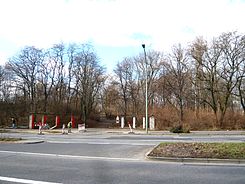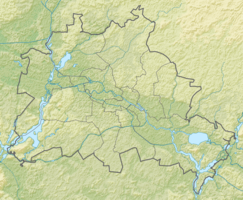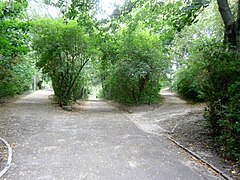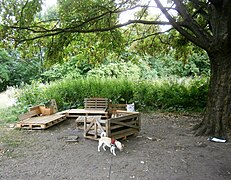Volkspark Anton Saefkow
| Volkspark Anton Saefkow | ||
|---|---|---|
| Park in Berlin | ||

|
||
| Park entrance on Kniprodestrasse; 2011 | ||
| Basic data | ||
| place | Berlin | |
| District | Prenzlauer Berg | |
| Created | 1951-1955 | |
| Surrounding streets |
Ringbahntrasse (north-east), Greifswalder Strasse (north-west), Kniprodestrasse (south) and Anton-Saefkow-Strasse (south-west) |
|
| use | ||
| User groups | Foot traffic ; leisure | |
| Technical specifications | ||
| Parking area | 8.5 hectares | |
|
52 ° 32 '11.8 " N , 13 ° 26' 38.3" E
|
||
The Volkspark Anton Saefkow is located in the Berlin district of Prenzlauer Berg in the Pankow district . It is named after the German communist and resistance fighter against National Socialism Anton Saefkow .
location
The slightly hilly park with an area of eight hectares connects out of town to the “ Green City ” residential area . It is planned to tie a green ribbon between Anton-Saefkow-Park over the bridge on Greifswalder Straße to Ernst-Thälmann-Park. The park area lies between Greifswalder and Kniprodestrasse, the southern end is the Anton-Saefkow-Strasse and to the north-east the site of the former freight station closes off with the ring railway. There is a connection to Arnswalder Platz via Bötzowstraße. The park is integrated into Berlin's main green path system , so the Hönower Weg continues from southern Friedrichshain to Einsteinpark . The inner parking ring runs through it in the longitudinal direction parallel to the circular track . The approximately fifteen meter high plateau is offset from Kniprodestrasse, where the park is 180 meters wide. In the direction of Greifswalder Strasse, the support point of the Green Space Office is located on the properties at Anton-Saefkow-Strasse 27 and 33 and narrows the width of the Volkspark to ten meters.
history
The area around today's park was used for agricultural purposes until the end of the 19th century. Little by little, residential buildings and industrial and transport structures were built, for example a cement works and the Greifswalder Strasse freight station . After the end of the Second World War , the Berlin administration had rubble from the cleared war ruins and rubble dumped on the area between 1948 and 1950 . Then there were light railways and work trains of the Berlin tram as debris railways and trucks used. The facility was heaped up to about 15 meters and formed hilly, covered with topsoil , greened and opened on September 18, 1955 as Park Gumbinner Grund . A total of around 40,000 cubic meters of material was used as the basis for final disposal. The name was derived from the Gumbinner Straße running next to it .
Three years later a bust of the resistance fighter was erected, which was made from Swedish granite by the sculptor Hans Kies . The park was named exactly eleven years after Anton Saefkow's death, at the same time as Gumbinner Straße was renamed. The park is said to have a “strong impact on the cityscape”.
State and outlook
An investigation on behalf of the Pankow District Office in 2012 revealed that there was a considerable need for action to renovate and upgrade the park. The estimated 1.5 million euros should also improve the access situation. In 2013, the two playgrounds were renovated for 20,000 euros, and a year later for a further 130,000 euros. According to a survey, however, the park is more frequented by the elderly and families who come here for barbecues.
In the 1970s to 1990s, “the lack of maintenance for a long time has turned this park into an unspoilt piece of nature that is actually too good to be domesticated.” “The entrances should be made more visible and the pergola on Kniprodestrasse should be redesigned. […] Asphalting is planned for sloping paths - if possible in a yellow shade to imitate a sandy path. ”However, renovation and design of the park has been postponed after autumn 2017.
gallery
literature
- Angela M. Arnold, Gabriele von Griesheim: rubble, railways and districts. Berlin 1945–1955. Self-published Berlin 2002, ISBN 3-00-009839-9 .
Web links
- Report on the preliminary investigation in Thälmannpark , report by Stattbau Berlin on behalf of the Pankow district office, (PDF; 1.7 MB)
- The park is in the panel of the "berlin brandenburg film commission"
Individual evidence
- ↑ How the residents want their park In: Berliner Woche, October 29, 2015: “We are planning to upgrade the park further in the coming years,” explains City Councilor Kirchner. The district has already had two playgrounds upgraded. 150,000 euros flowed into new play equipment and seating.
- ^ Plan of Berlin. Sheet 4228 and Straube-Plan I G; I L; I M ( Memento of the original from November 9, 2015 in the Internet Archive ) Info: The archive link has been inserted automatically and has not yet been checked. Please check the original and archive link according to the instructions and then remove this notice. with Soldner coordinates X = 27615, Y = 23315
- ^ Plan of Berlin. Straube-Plan I G (1910) and from 1929 sheet 4228 ( memento of the original from November 9, 2015 in the Internet Archive ) Info: The archive link was inserted automatically and has not yet been checked. Please check the original and archive link according to the instructions and then remove this notice. . Soldner coordinates: X = 27615, Y = 23315
- ^ Arnold, von Griesheim: rubble, railways and districts . Pages 172-177.
- ↑ Gumbinner Grund in Berlin-Kalender from September 18 , accessed on February 26, 2014
- ^ Anton Saefkow, 1957–58 ( Memento from March 5, 2014 in the Internet Archive ), website of Sculpture in Berlin, accessed on February 24, 2014.
- ↑ Report on the preliminary investigation in Thälmannpark , report by Stattbau Berlin on behalf of the Pankow district office, (PDF; 1.7 MB), accessed on February 24, 2014.
- ↑ Ulrike Forßbohm: Kriegs-End-Moränen - On the monument value of the mountains of rubble in Berlin , (PDF), p. 79, website of the TU Berlin, accessed on February 24, 2014.
- ↑ Anton-Saefkow-Park should be carefully de-wild in: Prenzlberger Voice, July 12, 2016







